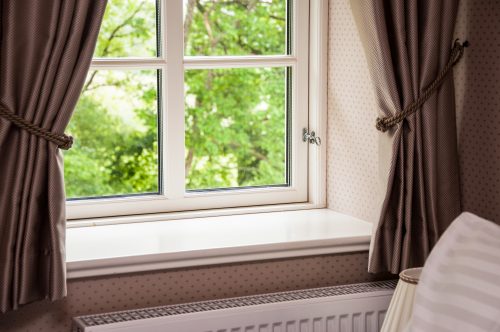Welcome to the Energy Efficiency Myths series from Direct Energy! As many myths arise from incomplete knowledge, they can create seemingly possible answers that many people accept as fact. Each month, we will examine common misunderstandings about energy efficiency — whether it’s in your home or about the energy industry — and deliver real facts behind the myth (and how they they might be costing you money).
Outlet Gaskets and Air Leakage: True Or False? If you feel cold air coming out from around an outlet or light switch, then putting an outlet gasket underneath the coverplate will help eliminate it. The expectation is that the more you use, the more drafts you’ll prevent and the better air sealed your home will be. It sounds like a real good idea. Except, there’s some research showing these gaskets are only a partial solution. It turns out that with only a few more steps, you can make this repair even more effective.
An insulating foam gasket is a bit of foam that fits under the receptacle coverplate. Ideally, the gasket should extend completely over the edges of the junction box to prevent cold drafts from getting around. Unfortunately, they don’t always do the job perfectly because there can be a LOT of air moving through wall and out around the gasket. Most homeowners don’t realize that their light switches and outlets are mounted in a junction box. These boxes sit in 3” x 5” holes in the wall and for the most part, are not air sealed, especially since they have holes in the back where wiring enters. The reason the air is moving in the wall comes from the stack effect.
The Stack Effect
The stack effect happens when warm air in the upper floors finds a way to leave the structure —it can be through poorly sealed attic doors, windows, unsealed plumbing or wiring entrances into the attic, cracks or gaps in framing, etc. When that warmed air leaves, it creates a vacuum that pulls in more air behind it from anywhere lower down in the building, such as dryer or furnace vents, drafty windows and doors, as well as crack and gaps in the building framing and sheathing. If you notice drafts coming from outlets or light switches on your exterior walls, one thing you can infer is that there are probably places further down in your home’s structure where outside air is getting into that wall. Wiring may enter into a section of wall through a hole in the bottom of the wall’s framing and exit through another hole at the top. Anywhere there’s a hole of any size leading outdoors, outside air will get into the structure and gradually move upwards.
In reality, there are plenty of places for air leaks to get into your home. Sealing as many of them as you can is the trick to saving money because the more you seal, the lower the influence of the stack effect.
Fixing Leaky Junction Boxes
Nevertheless, sealing up outlets and wall switches is still a good idea but it’s more effective when you use a foam outlet gasket and seal the junction box.
How to seal a junction box safely:
- Turn the off the breaker on the outlets you’ll be working on.
- Use a non-expanding latex foam. Because expanding foam ignites at 250°F, it must not leak into the junction box.
- Insert the tube in the gap between the junction box and the wall and spray the foam all the way around the junction box.
- Wipe away any excess and allow to dry and cure.
- Install outlet gasket and coverplate.
Junction boxes protect wire splices and connection from damage and moisture. If there’s a loose connection, the box will protect the wall from sparks and heat that could cause a fire. Some experts advise sealing holes in the junction boxes of existing older homes with fire blocking caulk. But because electrical code specifies that junction boxes need to have a minimum volume of open air space to dissipate heat, never fill an electrical box with expanding foam.
If you are thinking about remodeling your home, there are several products now available that provide an insulation space around the junction box. One example, called Box Shell, staples in place around the junction box and can be filled with foam to eliminate air leaks.
